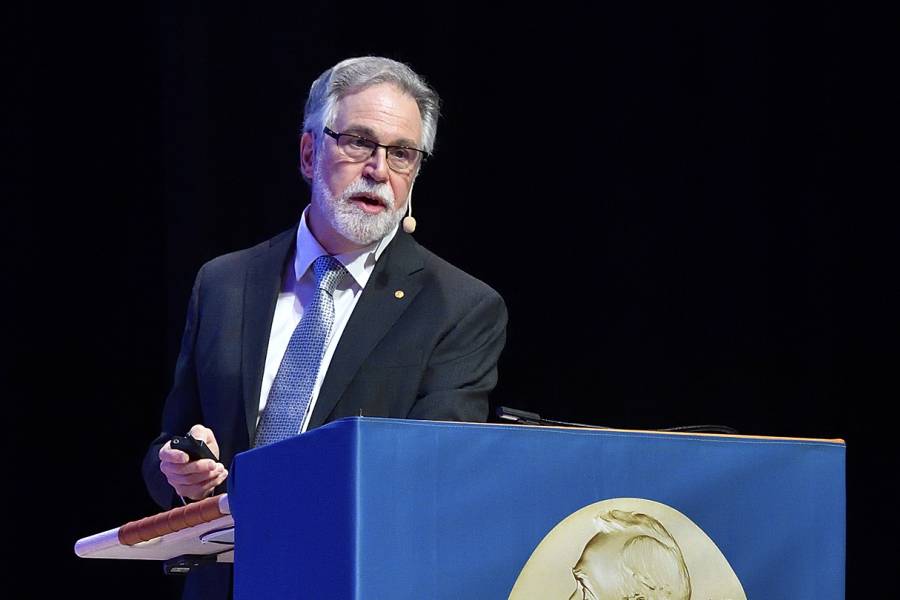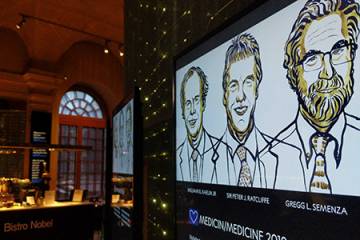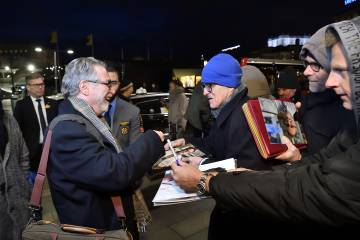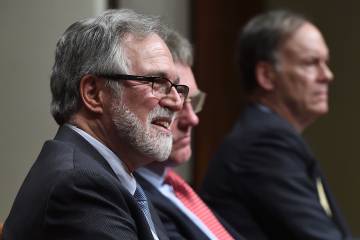STOCKHOLM—During his distinguished career, Gregg Semenza has given hundreds of lectures. In fact, for general scientific audiences, the Johns Hopkins University School of Medicine professor often gives a longer version of the very talk he presented on Sunday—detailing his discovery of the HIF-1 protein's role in human cell oxygen level regulation—during his Nobel Prize lecture at the Karolinska Institutet's Aula Medica auditorium.
But he's never presented to such a large crowd, let alone for such a crowning career achievement.
At the end of his Nobel Prize lecture, where in 30 minutes he effortlessly synthesized three decades of research on how the human body adapts to changes in oxygen availability, Semenza took ample time to thank the many people responsible for bringing him to this moment.
He dedicated his lecture to his high school biology teacher, Rose Nelson, pictured prominently in a slide of the many scientists whom he learned from.
Video credit: Len Turner and Dave Schmelick
"Dr. Nelson was my inspiration in science. I'm here because of her," Semenza told the crowd. He also thanked his early mentors at Johns Hopkins, chiefly professors of genetic medicine Haig Kazazian and Stylianos Antonarakis, both in the audience, and the late Victor McKusick, hailed as the "father of medical genetics." Indeed, the list of acknowledgments was long and detailed, naming nearly 150 faculty colleagues as well as students and postdocs who have collaborated with him over the years.
But before he was done, Semenza flashed a slide of his family—of him with his wife and three children—taken on the beach during a vacation to Maine this past summer. "And last but not least, I'd like to thank …" he began before pausing, tears welling in his eyes, voice cracking. He bowed his head briefly. In an instant, the emotion of the moment overtook him. Sensing the heartfelt struggle, the packed house of more than 800 attendees came to his aid with a roar of applause.
"Thank you," Semenza said, before pausing to take in a deep breath. "OK. I've got it together. I'd like to thank my wife, Laura; my sons, Evan and Gabe; my daughter, Allie, for always being there for me. Giving me unconditional love and support."
The moment was out of character for the usually reserved physician-scientist, but it gave a hint of the many emotions bubbling just beneath the surface during perhaps the most momentous week of his life.
"At that moment, I was feeling the power of my feelings for those people, particularly for my family, and it just became really kind of overwhelming," Semenza said the next morning. "That's never happened to me before. ... It caught me by surprise."
Video credit: Nobel Prize
On many occasions, Semenza has said sharing this Nobel Prize experience with family and friends is the pinnacle of the trip. A group of 30 family members and close friends have traveled to Stockholm to celebrate the week with him, including his four siblings, his mother, and her twin sister.
Beth Murphy, Semenza's sister, said it was both touching and surprising to see her older brother break down on stage, if only for a moment.
"It's not like him, for him to tear up like that," she said. "But obviously he went someplace deep inside of him."
She added that it's already been an emotional few days for their family as they share this unique experience with him, touring Stockholm and taking part in Nobel Week activities.
"I really, really love seeing how happy Gregg is," she said. "This is his life's work. To see him smiling from ear to ear the whole time is just fabulous."

Image credit: Will Kirk / Johns Hopkins University
Semenza's siblings have said the fame and attention of receiving science's highest honor have certainly not gotten to their brother, who has been celebrated at nearly every turn since he received news of the award in early October.
"He's the same humble, hardworking, and quiet guy he's always been," said brother Matt Semenza. "For us, it's been very exciting. I got to see him win the Gairdner Award [for Biomedical Research] in Toronto and the 2016 Albert Lasker Basic Medical Research Award in New York. So this is like the apogee of the award road trip we've been on with him."
Laurene Graig, Semenza's sister, added that while the emotional moment on stage might have been out of character, her brother's unselfishness and humility are not.
"I really appreciate that [Gregg] has recognized all the people who have helped and supported him along the way," she said. "I think it takes a certain amount of grace to do that. I'm very proud of him. We all are. There's been a lot of 'we' when he talks, not 'I' or "my.'"

Image caption: Semenza (center) with his family
Image credit: Will Kirk / Johns Hopkins University
When asked about his accomplishments and research, Semenza frequently credits others, and considers himself fortunate to happen upon the discoveries that brought him to this point. He traces it all back to his days growing up in New York.
Born in New York City in 1956, Semenza spent his formative years in Tarrytown, New York, a village located in Westchester County along the Hudson River. Semenza called it a "great place to grow up," a small-town atmosphere only a few train stops away from New York City where he would often go on the weekends to tour museums. His mother, Kathryn, taught at an elementary school, so learning and education were always priorities for the young Semenza.
At Sleepy Hollow High School, he learned to love science from Nelson, who during his junior year alerted him to an opportunity to take part in a National Science Foundation summer program at the Boyce Thompson Institute for Plant Research, an independent research institute then located in Yonkers, New York, and now located on the campus of Cornell University in Ithaca.
Photos from Stockholm
There he would do simple experiments like exposing plants to viruses and detailing the signs of infection.
"I was all thumbs back then because this was the first time I'd done it," Semenza said. "But I still enjoyed it. And this experience was really important for me because it showed me this was something I'd like to do for a career. … It was just one more link in the chain of events that led me on the path that ended up here."
This exposure to science at such a young age, and the mentoring he received from Nelson, is largely why Semenza now champions STEM education and the teaching profession. That was what compelled him to not only dedicate his Nobel Prize lecture to Nelson, he said, but also to share the long list of undergraduate students, graduate students, and postdocs who have worked with him over the past three decades at Johns Hopkins.
"I stopped doing experiments in my lab back in 1996," he said. "Since then, all the data has been generated by students and trainees. I can have all the greatest ideas in the world, but science is about generating data. If I didn't have all these people doing that, all these ideas wouldn't matter. We're not philosophers. We're scientists. If we have an idea, if we have a hypothesis, we have to prove it."
Mentoring students, he says, has been vitally important to him, as he feels the need to repay the debt of what his mentors did for him and pay it forward to the next generation.
That next generation was notably present at his Nobel Prize lecture, a celebration of science that many consider the most exciting part of the week as people get to hear directly from the Nobel laureates about their significant contributions to their fields. A long line of mostly students and young researchers snaked around the Aula Medica building that day, down steps and around the block, students such as Stephanie Chanda, a first-year biomedicine master's student at the Karolinska Institutet who had been in line with friends for hours to ensure she got in and got a good seat. "Of course, we are very interested in the Nobel lecture because we want to be researchers ourselves one day," Chanda said.
Also in the crowd were Semenza's family and friends and colleagues, including several of those he thanked in his talk.
"Having family and friends here is really the most important part of this experience, sharing this with them," Semenza said. "It's been great to have [my mom] here. Nobody has been more excited than she has. She's become something of a local celebrity back in Tarrytown, appearing in all the media, newspaper and television. ... She's very into it. And she deserves the attention.
"It's been an exciting week," he added, "from the time we stepped out of the car at the Grand Hotel to the throng of autograph seekers standing out in the cold waiting for us to come, to the thrill of giving the Nobel lecture yesterday. And having so many friends and family here to enjoy it with. That's really what has made it most special for me."
Posted in Health, Science+Technology, University News
Tagged nobel prize, gregg semenza











